
A banyan, also spelled banian, is a fig that develops accessory trunks from adjacent prop roots, allowing the tree to spread outwards indefinitely. This distinguishes banyans from other trees with a strangler habit that begin life as an epiphyte, i.e. a plant that grows on another plant, when its seed germinates in a crack or crevice of a host tree or edifice. "Banyan" often specifically denotes Ficus benghalensis, which is the national tree of India, though the name has also been generalized to denominate all figs that share a common life cycle and used systematically in taxonomy to denominate the subgenus Urostigma.
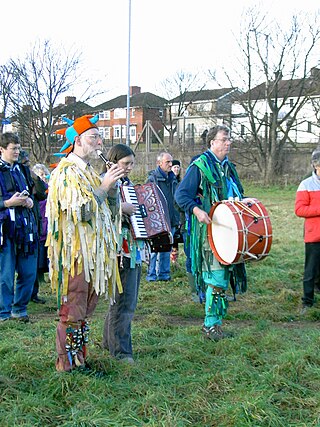
The tradition of wassailing falls into two distinct categories: the house-visiting wassail and the orchard-visiting wassail. The house-visiting wassail is the practice of people going door-to-door, singing and offering a drink from the wassail bowl in exchange for gifts; this practice still exists, but has largely been displaced by carol singing. The orchard-visiting wassail refers to the ancient custom of visiting orchards in cider-producing regions of England, reciting incantations and singing to the trees to promote a good harvest for the coming year. Notable traditional wassailing songs include "Here We Come a-Wassailing", "Gloucestershire Wassail", and "Gower Wassail".

A wishing well is a term from European folklore to describe wells where it was thought that any spoken wish would be granted. The idea that a wish would be granted came from the notion that water housed deities or had been placed there as a gift from the gods. This practice is thought to have arisen because water is a source of life, and was often a scarce commodity.

Yakshinis or yakshis are a class of female nature spirits in Hindu, Buddhist, and Jain religious mythologies that are different from devas and asuras, and gandharvas or apsaras. Yakshinis and their male counterparts, the yakshas, are one of the many paranormal beings associated with the centuries-old sacred groves of India. Yakshis are also found in the traditional legends of Northeastern Indian tribes, ancient legends of Kerala, and in the folktales of Kashmiri Muslims. Sikhism also mentions yakshas in its sacred texts.

Vat Purnima is a Hindu celebration observed by married women in Nepal, North India and in the Western Indian states of Maharashtra, Goa and Gujarat. On this Purnima during the three days of the month of Jyeshtha in the Hindu calendar, a married woman marks her love for her husband by tying a ceremonial thread around a banyan tree. The celebration is based on the legend of Savitri and Satyavan as narrated in the epic Mahabharata.
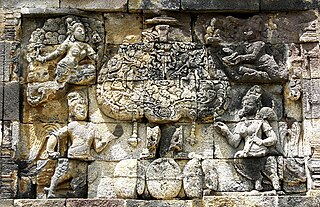
Kalpavriksha is a wish-fulfilling divine tree in Indian religions, like Hinduism, Jainism, and Buddhism. In Buddhism, another term, ratnavṛkṣa, is also common. Its earliest descriptions are mentioned in Sanskrit literature. It is also a popular theme in Jain cosmology and Buddhism.

The Lam Tsuen Wishing Trees are a popular shrine in Hong Kong located near the Tin Hau Temple in Fong Ma Po Village, Lam Tsuen. The temple was built around 1768 or 1771, during the reign of the Qianlong Emperor in the Qing dynasty (1644–1912).

The Apple Wassail is a traditional form of wassailing practiced in the cider orchards of Southern England during the winter. There are many well recorded instances of the Apple Wassail in the early modern period. The first recorded mention was at Fordwich, Kent, in 1585, by which time groups of young men would go between orchards performing the rite for a reward. The practice was sometimes referred to as "howling". On Twelfth Night, men would go with their wassail bowl into the orchard and go about the trees. Slices of bread or toast were laid at the roots and sometimes tied to branches. Cider was also poured over the tree roots. The ceremony is said to "bless" the trees to produce a good crop in the forthcoming season. Among the most famous wassail ceremonies are those in Whimple, Devon and Carhampton, Somerset, both on 17 January.
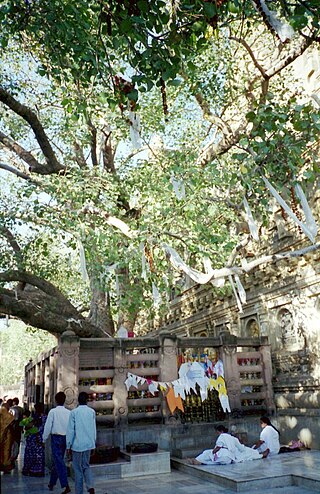
Trees are significant in many of the world's mythologies, and have been given deep and sacred meanings throughout the ages. Human beings, observing the growth and death of trees, and the annual death and revival of their foliage, have often seen them as powerful symbols of growth, death and rebirth. Evergreen trees, which largely stay green throughout these cycles, are sometimes considered symbols of the eternal, immortality or fertility. The image of the Tree of life or world tree occurs in many mythologies.
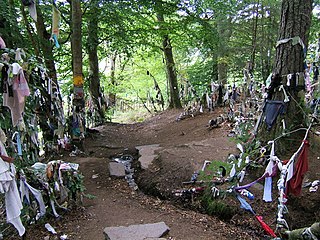
A clootie well is a holy well, almost always with a tree growing beside it, where small strips of cloth or ribbons are left as part of a healing ritual, usually by tying them to branches of the tree. Clootie wells are places of pilgrimage usually found in Celtic areas. It is believed the tradition comes from the ancient custom of leaving votive offerings in water. In Scots, a clootie or cloot is a strip of cloth or rag.

A touch piece is a coin or medal believed to cure disease, bring good luck, influence people's behaviour, carry out a specific practical action, etc.

Saint Nectan's Glen is an area of woodland in Trethevy near Tintagel, north Cornwall stretching for around one mile along both banks of the Trevillet River. The glen's most prominent feature is St Nectan's Kieve, a spectacular sixty foot waterfall through a hole in the rocks. The site attracts tourists who believe it to be "one of the UK's most spiritual sites," and tie or place ribbons, crystals, photographs, small piles of flat stones and other materials near the waterfall.
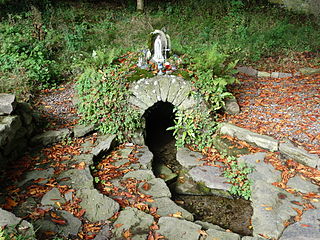
A holy well or sacred spring is a well, spring or small pool of water revered either in a Christian or pagan context, sometimes both. The water of holy wells is often thought to have healing qualities, through the numinous presence of its guardian spirit or Christian saint. They often have local legends associated with them; for example in Christian legends, the water is often said to have been made to flow by the action of a saint. Holy wells are often also places of ritual and pilgrimage, where people pray and leave votive offerings. In Celtic regions, strips of cloth are often tied to trees at holy wells, known as clootie wells.

Nang Ta-khian is a female spirit of the folklore of Thailand. It manifests itself as a woman that haunts Hopea odorata trees. These are very large trees known as Ta-khian (ตะเคียน) in Thai, hence her name.
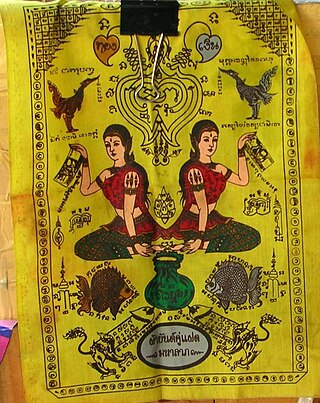
Thai folklore is a diverse set of mythology and traditional beliefs held by the Thai people. Most Thai folklore has a regional background for it originated in rural Thailand. With the passing of time, and through the influence of the media, large parts of Thai folklore have become interwoven with the wider popular Thai culture.

Belief in ghosts in Thai culture is both popular and enduring. In the history of Thailand, Buddhist popular beliefs intermingled with legends of spirits or ghosts of local folklore. These myths have survived and evolved, having been adapted to the modern media, such as Thai films, Thai television soap operas, and Thai comics.
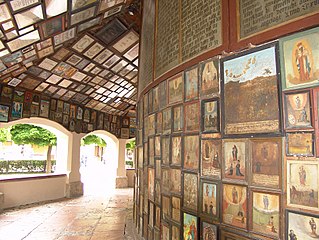
A votive offering or votive deposit is one or more objects displayed or deposited, without the intention of recovery or use, in a sacred place for religious purposes. Such items are a feature of modern and ancient societies and are generally made in order to gain favor with supernatural forces.

The Lady's Well is a natural spring surmounted by a large cross that stands beside the Stra Burn Ford (NS254630) near Auchmannoch House in the Parish of Sorn, East Ayrshire, Scotland. It is associated with the Virgin Mary as a curative well, a Wishing Well and also a Clootie well, additionally Mary Queen of Scots is said to have once watered her horse here. A large red sandstone cross was erected here at an unrecorded date. The well is also said to have acquired its name through "..one of the ladies of Auchmannoch family drinking water exclusively from here."

Nang Mai is a ghost from Thai folklore that inhabits a large tree. They build a palace in the tree, but nobody can see it, and if anyone cuts that tree, the cutter will be cursed, grow sick, or even become crazy.


































